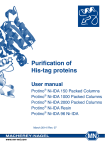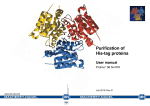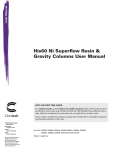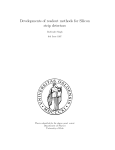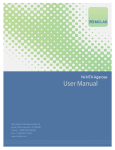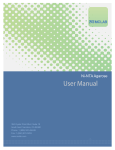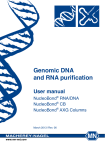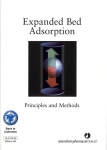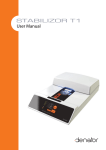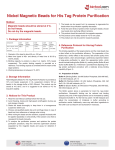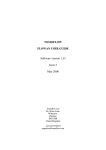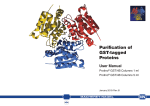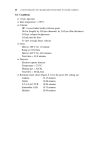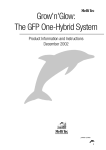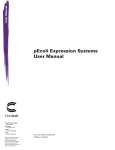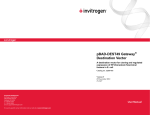Download Ni-IDA Resin
Transcript
Purification of Polyhistidine-Tagged Proteins User manual Protino® Ni-IDA 150 packed columns Protino® Ni-IDA 1000 packed columns Protino® Ni-IDA 2000 packed columns Protino® Ni-IDA Resin Protino® Multi-96 Ni-IDA June 2006/Rev. 03 www.mn-net.com MACHEREY-NAGEL MN MACHEREY-NAGEL EN ISO 9001: 2000 CERTIFIED MACHEREY-NAGEL MN Purification of Polyhistidine-Tagged Proteins Table of contents 1 Contents 5 2 Introduction 7 2.1 The basic principle 7 2.2 About this user manual 8 3 Product description 10 3.1 Specifications 10 3.2 Purification under native and denaturing conditions ® 11 3.3 Binding capacity of Protino Ni-IDA 12 3.4 Culture size 15 3.5 Binding, washing, and elution 19 3.6 Buffer compositions 20 3.7 Materials to be supplied by the user 22 ® 3.8 Protino Columns for gravity-flow column chromatography using Protino® Ni-IDA Resin 23 3.9 Compatibility of reagents 24 3.10 Storage conditions 25 4 Safety instructions – risk and safety phrases 26 5 Purification of polyhistidine-tagged proteins from E. coli under native conditions 27 5.1 Preparation of cleared lysates under native conditions ® 5.2 Protino Ni-IDA packed columns – purification under native conditions 27 28 ® 5.3 Protino Ni-IDA Resin – gravity-flow column chromatography under native conditions 31 5.4 Protino® Ni-IDA Resin – batch/gravity-flow column chromatography under native conditions 32 5.5 Protino® Ni-IDA Resin – batch purification protocol under native conditions 33 ® 5.6 Protino Ni-IDA Resin – medium pressure column chromatography under native conditions 34 5.7 Protino® Multi-96 Ni-IDA – purification under native conditions 36 6 Purification of polyhistidine-tagged proteins from E. coli under denaturing conditions 6.1 Cell extract preparation under denaturing conditions MACHEREY-NAGEL – 06/2006/ Rev. 03 39 39 3 Purification of Polyhistidine-Tagged Proteins 6.2 Protino® Ni-IDA packed columns – purification under denaturing conditions 41 6.3 Protino® Ni-IDA Resin - gravity-flow column chromatography under denaturing conditions 42 7 Storage, reuse, and regeneration of Protino® Ni-IDA Resin 43 8 Appendix 44 4 8.1 Troubleshooting 44 8.2 Ordering information 46 8.3 Product use restriction / warranty 47 MACHEREY-NAGEL – 06/2006/ Rev. 03 Purification of Polyhistidine-Tagged Proteins 1 Contents Protino® Ni-IDA 150 packed columns 10 preps 50 preps 745150.10 745150.50 10 50 8x LEW buffer 5 ml 25 ml 4x Elution buffer 5 ml 20 ml 1 1 Cat. No. Protino® Ni-IDA 150 packed columns Protocol Protino® Ni-IDA 1000 packed columns 5 preps 50 preps 745160.5 745160.50 5 50 8x LEW buffer 30 ml 2 x 70 ml 4x Elution buffer 25 ml 115 ml Plastic washer 5 8 Protocol 1 1 Cat. No. Protino® Ni-IDA 1000 packed columns Protino® Ni-IDA 2000 packed columns 5 preps 25 preps 745170.5 745170.25 5 25 8x LEW buffer 30 ml 2 x 70 ml 4x Elution buffer 25 ml 115 ml Plastic washer 5 8 Protocol 1 1 Cat. No. Protino® Ni-IDA 2000 packed columns MACHEREY-NAGEL – 06/2006/ Rev. 03 5 Purification of Polyhistidine-Tagged Proteins 1 Contents continued Protino® Ni-IDA Resin Cat. No. 745210.5 745210.30 745210.120 745210.600 5g 30 g 120 g 600 g 1 1 1 1 Protino® Ni-IDA Resin Protocol Protino® Multi-96 Ni-IDA 1 x 96 preps 4 x 96 preps 745300.1 745300.4 1 4 8x LEW buffer 70 ml 210 ml 4x Elution buffer 30 ml 115 ml 1 1 Cat. No. Protino® Multi-96 Ni-IDA Plate Protocol 6 MACHEREY-NAGEL – 06/2006/ Rev. 03 Purification of Polyhistidine-Tagged Proteins 2 Introduction 2.1 The basic principle Protino® Ni-IDA products enable fast and convenient purification of recombinant polyhistidine-tagged proteins by immobilized metal ion affinity chromatography (IMAC). Protino® Ni-IDA is a dry silica-based resin precharged with Ni2+ ions. Binding of protein is based on the interaction between the polyhistidine tag of the recombinant protein and immobilized Ni2+ ions. The chelating group of Protino® NiIDA is based on IDA (iminodiacetic acid), which enables strong and efficient binding of target protein onto the IMAC matrix (Figure 1). In contrast to traditional IDA matrices, Protino® Ni-IDA shows an optimized, low density of IDA ligands, which is created by a special manufacturing process. This non-saturating surface concentration of IDA eliminates non-specific interactions of contaminating proteins with the adsorbent. As a result, Protino® Ni-IDA ensures higher target protein purity. IDA is a threedentate chelator which occupies three of the six binding sites in the coordination sphere of the Ni2+ ion. The remaining three coordination sites are usually occupied by water molecules and can be exchanged with histidine residues of the recombinant protein (Figure 1). H2O CO CH2 O N 2+ Ni H2O CH2 O CO H2O Silica Bead Figure 1. Protino® Ni-IDA - Structure of IDA in complex with Ni2+. MACHEREY-NAGEL – 06/2006/ Rev. 03 7 Purification of Polyhistidine-Tagged Proteins 2.2 About this user manual For quick orientation in this user manual please follow the corresponding crossreference given below. Product Application Page(s) Protino® Ni-IDA packed columns Gravity flow column chromatography 28, 38 Protino® Ni-IDA Resin Gravity flow column chromatography 31, 39 Batch binding (in combination with 32 gravity flow column chromatography) Protino® Multi-96 Ni-IDA Batch purification 33 Medium pressure column chromatography (FPLC) 34 Gravity flow column chromatography 37 Protino® Ni packed columns: Experienced users who are performing the purification of His tagged proteins using Protino® Ni packed columns may refer to the Protocol-at-a-glance instead of this user manual (see section 5.2.1). The Protocol-at-a-glance is designed to be used only as a supplemental tool for quick referencing while performing the purification procedure. First-time users are strongly advised to read this user manual. The Protino® Ni packed columns protocols in this manual are organized as follows: The culture volumes and volumes of the respective buffers used for a particular column size are highlighted. Each procedural step is arranged like the following example (taken from section 5.2.2): Protino® Ni-IDA packed columns 150 3 1000 2000 Column equilibration Equilibrate Protino® Ni packed columns with 1x LEW Buffer. Allow the column to drain by gravity 320 l 2 ml 4 ml Protino® Ni 150/1000 packed columns are designed to fit into most 15 ml conical centrifuge tubes (e.g. BD Falcon Cat. No. 352097) for convenient fraction collection. 8 MACHEREY-NAGEL – 06/2006/ Rev. 03 Purification of Polyhistidine-Tagged Proteins For example, if you are using Protino® Ni-IDA 150 packed column you are requested to refer to the white boxes. These boxes indicate the volume of bacterial culture or buffer to be used. The respective buffer is highlighted in bold type within the instruction. Referring to the a.m. example there has to be used 320 l of LEW buffer for column equilibration when using Protino® Ni-IDA 150 packed columns. MACHEREY-NAGEL – 06/2006/ Rev. 03 9 Purification of Polyhistidine-Tagged Proteins 3 Product description 3.1 Specifications Table 1: Specifications Protino® Ni-IDA packed columns Protein capacity (6xHis-GFPuv, ~32kDa) 150 1000 2000 800 g (40 mg resin) 5 mg (250 mg resin) 10 mg (500 mg resin) Application Gravity flow columns Physical form Ready-to-use columns, filled with dry matrix precharged with Ni2+ Specifications Protino® Ni-IDA Resin Protein capacity (6xHis-GFPuv, ~32kDa) 20 mg /g resin 10 mg /ml bed volume Application Batch Gravity flow column FPLC Physical form Dry matrix, precharged with Ni2+ Max. pressure 1450 psi (100 bar) Specifications Protino® Multi-96 Ni-IDA Protein capacity (6xHis-GFPuv, ~32kDa) Application Physical form 1 mg/well (50 mg resin/well) Gravity flow chromatography Ready-to-use 96-well plates, filled with dry matrix precharged with Ni2+ Specifications Protino® Ni-IDA packed columns, Resin, and Multi-96 kits Matrix Macroporous silica Density 0.5 g/ml (1 g resin corresponds to 2 ml bed volume) Chelating group IDA (iminodiacetic acid) The nomenclature of the Protino® packed columns is independent from the binding capacity but is to reflect the dimension of the column such as small, medium, and large. 10 MACHEREY-NAGEL – 06/2006/ Rev. 03 Purification of Polyhistidine-Tagged Proteins Specifications Protino® Ni-IDA packed columns, Resin, and Multi-96 kits Mean particle size 90 m pH stability 3 - 7.5 ( 2 h) 2 - 3 or 7.5 - 8.5 ( 2 h) Storage 25 °C Recommended imidazole concentration for load/wash 0 mM Recommended imidazole concentration for elution 250 mM • Protino® Ni-IDA products enable routine purification of recombinant polyhistidine-tagged proteins under native or denaturing conditions. • Although designed for the purification of polyhistidine-tagged proteins from E. coli, Protino® Ni-IDA products can also be used for the purification of polyhistidine-tagged proteins from other expression systems including insect cells, mammalian cells, and yeast. • The capacity of Protino® Ni-IDA (see Table 1) was determined by using polyhistidine-tagged green fluorescent protein (6xHis-GFPuv, ~32 kDa) expressed in E. coli. Capacities will vary for each His-tagged protein. 3.2 Purification under native and denaturing conditions This manual describes methods for the preparation of cell extracts from E. coli and procedures for the purification of polyhistidine-tagged recombinant proteins using Protino® Ni-IDA. If recombinant proteins are expressed in E. coli ideally the target proteins remain soluble in the cytoplasm. However, especially proteins that are highly expressed accumulate in insoluble aggregates, which are called inclusion bodies. For solubilization of inclusion bodies buffers containing large amounts of denaturants are used. This manual includes instructions for isolation of soluble proteins (purification under native conditions, see section 5) as well as insoluble proteins from inclusion bodies (purification under denaturing conditions, see section 6). In general for purification of polyhistidine-tagged proteins, the bacterial cells are disrupted using lysozyme in combination with sonication. After centrifugation, soluble target protein is found in the supernatant while inclusion bodies remain in the pellet. The clear supernatant can directly be subjected to further purification using Protino® Ni-IDA packed columns or Protino® Ni-IDA Resin under native conditions (see section 5). In case of massive formation of inclusion bodies the target protein is extracted from the pellet using a denaturant (8 M urea) and further purified using protocols for the purification under denaturing conditions (see section 6). If the distribution of the recombinant protein is unknown it is recommended to perform SDS-PAGE analysis using the crude cell extract prior to centrifugation and the clear supernatant after centrifugation. While the crude cell extracts will contain both soluble and insoluble target protein, only soluble target protein is found in the supernatant. MACHEREY-NAGEL – 06/2006/ Rev. 03 11 Purification of Polyhistidine-Tagged Proteins 3.3 Binding capacity of Protino® Ni-IDA 3.3.1 General information The binding capacity of Protino® Ni-IDA strongly depends on the characteristics of the polyhistidine-tagged protein, e.g. amino acid composition, molecular weight, 3-D structure, oligomerization properties etc. Furthermore the absolute yield also depends on the total amount and concentration of the target protein in the sample which in turn directly correlate with the expression level and the cell density of the expression culture. Therefore binding capacity will vary for each polyhistidinetagged protein and has to be determined for each expression experiment. The binding behaviour of any polyhistidine-tagged protein to Protino Ni-IDA can be examined by calculating the amount of protein that is eluted as a function of the amount of protein that has been loaded (see Figure 2). Please note that the resulting graph will vary in dependence on characteristics and concentration of the individual His-tag protein. The binding curve can be divided in three stages: 1. Stage of maximum recovery. At this stage the loaded protein is bound to the resin nearly quantitatively and can be eluted nearly quantitatively, too (the binding curve is almost linear, see Figure 2, _ eluted His-GFPuv). 2. Stage of increasing yield/decreasing recovery. At this stage the binding curve becomes non-linear and finally binding approaches saturation. The protein yield increases with further increasing amount of loaded protein. 3. Stage of maximum yield/minimum recovery. When loading excess protein, the available binding sites of the resin are saturated. The amount of eluted protein reaches a maximum. The binding capacity for each individual protein can be defined as the yield, at which the binding curve changes from the stage of maximum recovery to the stage of increasing yield/decreasing recovery. This point is an optimal compromise between protein load and recovery and will vary for each individual protein. 3.3.2 Binding capacity The binding capacity of Protino Ni-IDA is exemplified using the green fluorescent protein (6xHis-GFPuv, ~32 kDa) at a concentration of 2 mg/ml. Please note that different recombinant proteins may show a different binding behaviour. Figure 2 shows a plot of the amount of eluted 6xHis-GFPuv against the amount of loaded 6xHis-GFPuv. The binding curve can be divided in three stages: 1. Stage of maximum recovery: <~ 20 mg 6xHis-GFPuv load/g resin 2. Stage of increasing yield/decreasing recovery: >~ 20 mg 6xHis-GFPuv load/g resin 3. Stage of maximum yield/minimum recovery: 12 >~ 75 mg 6xHis-GFPuv load/g resin MACHEREY-NAGEL – 06/2006/ Rev. 03 Purification of Polyhistidine-Tagged Proteins Under the above mentioned conditions the binding capacity of Protino Ni-IDA for 6xHis-GFPuv is approximately 20 mg protein per g of resin (see arrow, Figure 2). At this point the protein recovery is > 80%. Consequently the following amounts of 6xHis-GFPuv have to be loaded: For optimal recovery: load ~20 mg protein per 1 g of Protino Ni-IDA Resin, for maximum yield: load ~75 mg protein per 1 g of Protino NiIDA Resin. Figure 2. Binding behaviour of 6xHis-GFPuv to Protino® Ni-IDA Resin. Gravity flow columns packed with 40 mg of Protino Ni-IDA Resin were loaded with increasing volumes of an E. coli lysate containing 6xHis-GFPuv (protein concentration 2 mg/ml). After washing with 640 l LEW buffer the target protein was eluted with 960 l Elution buffer. Yield (left axis) and recovery (right axis) of 6xHisGFPuv are plotted versus the amount of loaded protein. For convenient analysis the values are converted to mg 6xHis-GFPuv per 1 g resin. MACHEREY-NAGEL – 06/2006/ Rev. 03 13 Purification of Polyhistidine-Tagged Proteins Recovery rates and yield can be increased by using samples containing higher concentrated polyhistidine-tagged protein (6xHis-GFPuv). Figure 3 shows that the yield of purified polyhistidine-tagged protein is not only depending on the total amount of target protein loaded on the column (also see Figure 2) but also on its concentration in the lysate. Consequently the concentration of target protein in the sample should be as high as possible. Figure 3: Binding behaviour of 6xHis-GFPuv to Protino® Ni-IDA at different concentrations of the polyhistidine-tagged protein in the sample. Recombinant 6xHis-GFPuv was expressed in E. coli. The concentration of the target protein in the culture reached 100 mg/l. 1 g cells were lysed in 2 ml LEW buffer according to section 3.4 in order to obtain a highly concentrated lysate. The concentration of 6xHis-GFPuv in the lysate was 8 mg/ml. Gravity flow columns packed with 40 mg of Protino® Ni-IDA Resin were loaded with increasing volumes (amounts) of the lysate. After washing, the target protein was eluted with Elution buffer. The yield of 6xHisGFPuv is plotted against the amount of loaded target protein. The same test was performed using diluted lysates with concentrations of 0.5 and 2 mg/ml. For convenient analysis the values are converted to mg 6xHis-GFPuv per 1 g resin. Please note: The higher the protein concentration in the sample and the higher the total amount of protein loaded on Protino Ni-IDA packed columns or Resin, the higher will be the absolute yields. For example if loading ~75 mg 6xHis-GFPuv (concentration: 8 mg/ml) per g Protino Ni-IDA Resin, a maximum yield of ~50 mg/g can be obtained. 14 MACHEREY-NAGEL – 06/2006/ Rev. 03 Purification of Polyhistidine-Tagged Proteins 3.4 Culture size As outlined above, the protein yield depends on various parameters. However, some recommendations on protein load and culture size can be given as a starting point. Note that yield and protein load are exemplified for the 6xHis-GFPuv (~ 32 kDa) and may vary from protein to protein. • Use rather high concentrations of the target protein in the sample. • For maximum yield use an excess amount of polyhistidine-tagged protein in the loaded sample. E.g. apply up to 75 mg of anticipated 6xHis-GFPuv per 1 g of Protino® Ni-IDA Resin. • For maximum recovery use up to 20 mg of 6xHis-GFPuv per 1 g of Protino® Ni-IDA Resin. The concentration of the polyhistidine-tagged protein in the culture may vary from < 1 mg/l up to 200 mg/l depending on cell density and expression level. It is recommended to determine the protein concentration for each expression experiment, e.g. via SDS-PAGE. On average, 250 ml of culture will produce approximately 1 g of pelleted, wet cells. • Transfer the cell lysate from a 200-750 ml (high expression at 100 mg/l) or 2000-7500 ml (low expression at 10 mg/l) E. coli culture to 1 g of Protino® NiIDA Resin. • In order to obtain highly concentrated lysates, lyse wet cells in 2-5 ml LEW buffer per 1 g wet mass. The volume of LEW buffer should be adjusted according to the amount of polyhistidine-tagged protein in the culture. For example, 1 g cells may be resuspended in 2-5 ml LEW buffer if a protein is expressed at 50-200 mg/l. For cultures with lower target protein content 1 g cells should be resuspended in 2 ml of LEW buffer. For recovering polyhistidine-tagged protein from E. coli cultures we recommend treatment with lysozyme in combination with sonication. If you are purifying recombinant protein from eukaryotic cells, treat the cells with an appropriate buffer containing a mild detergent (Sambrook et al., 1989). MACHEREY-NAGEL – 06/2006/ Rev. 03 15 Purification of Polyhistidine-Tagged Proteins Table 2: Determination of culture and buffer volume requirements Protino® Ni-IDA 2000 packed columns (500 mg Resin) Protino® Ni-IDA 1000 packed columns (250 mg Resin) Protino® Ni-IDA 150 packed columns (40 mg Resin) Protino® Ni-IDA Resin, 1g concentration of HisTag protein in the culture 1 results in amount of recommenprotein load ded E.coli culture volume [mg] [ml] [g] high, ~ 100 mg/l recoverymax 20 200 0.8 yieldmax 75 750 3 low, ~ 10 mg/l recoverymax 20 2000 8 yieldmax 75 7500 30 high, ~ 100 mg/l recoverymax 0.8 8 0.04 3 30 0.12 low, ~ 10 mg/l recoverymax 0.8 80 0.32 yieldmax 3 300 1.2 high, ~ 100 mg/l recoverymax 5 50 0.2 18.8 188 0.75 5 500 2 18.8 1880 7.5 10 100 0.4 37.5 375 1.5 10 1000 4 37.5 3750 15 low, ~ 10 mg/l yieldmax yieldmax recoverymax yieldmax high, ~ 100 mg/l recoverymax low, ~ 10 mg/l recoverymax yieldmax yieldmax On average, 250 ml of culture will produce approximately 1 g of pelleted, wet cells. 16 recommended E.coli pellet wet mass1 MACHEREY-NAGEL – 06/2006/ Rev. 03 Purification of Polyhistidine-Tagged Proteins Table 2: Determination of culture and buffer volume requirements (continued) Protino® Ni-IDA 2000 packed columns (500 mg Resin) Protino® Ni-IDA 1000 packed columns (250 mg Resin) Protino® Ni-IDA 150 packed columns (40 mg Resin) Protino® Ni-IDA Resin, 1g native conditions denaturing conditions LEW buffer1 (resuspension) LEW buffer1 (resuspension) LEW buffer1 (washing of IB3) DS buffer2 (lysis of IB3) [ml] [ml] [ml] [ml] 4 4 8 1.6 15 15 30 6 16 16 80 16 60 60 300 60 0.2 0.2 0.4 0.08 0.6 0.6 1.2 0.24 0.64 0.64 3.2 0.64 2.4 2.4 12 2.4 1 1 2 0.4 15 15 7.5 2.4 4 4 20 4 24 24 75 24 5 5 4 0.8 30 30 15 4.8 8 8 40 8 48 48 150 48 1 Lysis-Equilibration-Wash buffer Denaturing Solubilization buffer 3 Inclusion Bodies 2 MACHEREY-NAGEL – 06/2006/ Rev. 03 17 Purification of Polyhistidine-Tagged Proteins Figure 4. Required culture volumes and LEW buffer volumes for maximum protein recovery or maximum yield in dependence on protein expression level. The volumes noted below are only exemplary and are shown for 1 g of Protino® NiIDA Resin (purification under native conditions). Please use these recommendations as a starting point to evaluate optional purification results. Note that purification conditions have to be optimized for each individual polyhistidine-tagged protein. 1 g Protino® Ni-IDA Resin for maximum recovery for maximum yield load ~20 mg protein load ~75 mg protein high expression culture (~100 mg/l) low expression culture (~10 mg/l) high expression culture (~100 mg/l) low expression culture (~10 mg/l) use 200 ml culture use 2000 ml culture use 750 ml culture use 7500 ml culture (~0.8 g cell pellet) (~8 g cell pellet) (~3 g cell pellet) (~30 g cell pellet) resuspend in ~4 ml LEW (ratio 1:5) resuspend in ~16 ml LEW (ratio 1:2) resuspend in ~15 ml LEW (ratio 1:5) resuspend in ~60 ml LEW (ratio 1:2) ~4 ml of protein lysate ~16 ml of protein lysate ~15 ml of protein lysate ~60 ml of protein lysate (conc 5 mg/ml) (conc 1.25 mg/ml) (conc 5 mg/ml) (conc 1.25 mg/ml) 18 MACHEREY-NAGEL – 06/2006/ Rev. 03 Purification of Polyhistidine-Tagged Proteins 3.5 Binding, washing, and elution In contrast to traditional IDA matrices, Protino® Ni-IDA shows an optimized, low density of IDA ligands, which is created by a special manufacturing process. This non-saturating surface concentration of IDA eliminates non-specific interactions of contaminating proteins with the adsorbent. Since virtually no contaminating host proteins bind to Protino® Ni-IDA, stringent washing procedures are generally not necessary. Therefore LEW buffer, which is used for lysis, equilibration, and washing, does not contain any imidazole. Bound polyhistidine-tagged protein can competitively be eluted by adding imidazole. The recommended Elution buffer contains 250 mM imidazole in order to recover even strong binding, multimeric proteins with more than one polyhistidine tag (also see buffer compositions section 3.6). However, as shown in Figure 5, depending on the protein, elution may be equally effective in the presence of much lower imidazole concentrations. If, for example, the stability or integrity of the target protein in 250 mM imidazole is a concern the concentration of imidazole in the eluent may readily be reduced. Figure 5. Purification of polyhistidine-tagged GFPuv using Protino® Ni-IDA and Ni-IDA Agarose. Recombinant GFPuv was expressed in E. coli, lysed, loaded onto each gravity flow column, and eluted by a stepwise imidazole gradient. Eluted fractions were analyzed by SDS-PAGE. Pure polyhistidine-tagged protein can be eluted from Protino® Ni-IDA (left panel) at much lower imidazole concentrations than from Ni-IDA Agarose (right panel). In addition, Ni-IDA Agarose releases contaminating proteins from 10 mM to 100 mM imidazole. M = Marker proteins, CL = Cleared lysate. MACHEREY-NAGEL – 06/2006/ Rev. 03 19 Purification of Polyhistidine-Tagged Proteins 3.6 Buffer compositions 3.6.1 Buffers for purification under native conditions Protino® Ni-IDA 150/1000/2000 packed columns kits and Protino® Multi-96 Ni-IDA kits contain LEW/Elution buffer stock solutions that have to be diluted according to the instructions given in the individual protocol (see sections 5.2 and 5.7). Protino® Ni-IDA Resin kits do not contain any buffers. Prepare LEW buffer and Elution buffer according to the instructions given in this section. Note that lysis buffer, equilibration buffer, and washing buffer are the same. Note: Do not include any imidazole in the Lysis-Equilibration-Wash buffer, since most proteins do not bind to the resin in the presence of even low imidazole concentration! Lysis-Equilibration-Wash buffer (LEW buffer, 1 liter): • 50 mM NaH2PO4 7.8 g NaH2PO4 x 2 H2O (MW = 156.01 g/mol) • 300 mM NaCl 17.5 g NaCl (MW = 58.44 g/mol) • Adjust pH to 8.0 using NaOH Elution buffer (1 liter): 20 • 50 mM NaH2PO4 7.8 g NaH2PO4 x 2 H2O (MW = 156.01 g/mol) • 300 mM NaCl 17.5 g NaCl (MW = 58.44 g/mol) • 250 mM imidazole 17.0 g imidazole (MW = 68.08 g/mol) • Adjust pH to 8.0 using NaOH MACHEREY-NAGEL – 06/2006/ Rev. 03 Purification of Polyhistidine-Tagged Proteins 3.6.2 Buffers for purification under denaturing conditions Protino® Ni-IDA 150/1000/2000 packed columns kits contain stock solutions of LEW buffer and Elution buffer for purification under native conditions. For purification under denaturing conditions prepare Denaturing Solubilization buffer and Denaturing Elution buffer according to the instruction given in this section. Note that additional volumes of LEW buffer have to be prepared as well. Protino® Ni-IDA Resin kits do not contain any buffers. Prepare LEW buffer, Denaturing Solubilization buffer, and Denaturing Elution buffer according to the instruction given in this section. Note: Due to the dissociation of urea, prepare buffers immediately prior to use. Lysis-Equilibration-Wash buffer (LEW buffer, 1 liter): • 50 mM NaH2PO4 7.8 g NaH2PO4 x 2 H2O (MW = 156.01 g/mol) • 300 mM NaCl 17.5 g NaCl (MW = 58.44 g/mol) • Adjust pH to 8.0 using NaOH Denaturing Solubilization buffer (1 liter): • 50 mM NaH2PO4 7.8 g NaH2PO4 x 2 H2O (MW = 156.01 g/mol) • 300 mM NaCl 17.5 g NaCl (MW = 58.44 g/mol) • 8 M urea 480.5 g (MW = 60.06 g/mol) • Adjust pH to 8.0 using NaOH Denaturing Elution buffer (1 liter): • 50 mM NaH2PO4 7.8 g NaH2PO4 x 2 H2O (MW = 156.01 g/mol) • 300 mM NaCl 17.5 g NaCl (MW = 58.44 g/mol) • 8 M urea 480.5 g (MW = 60.06 g/mol) • 250 mM imidazole 17.0 g imidazole (MW = 68.08 g/mol) • Adjust pH to 8.0 using NaOH MACHEREY-NAGEL – 06/2006/ Rev. 03 21 Purification of Polyhistidine-Tagged Proteins 3.7 Materials to be supplied by the user • Appropriate centrifuge, sonicator • Appropriate centrifugation/collection tubes • Lysozyme • Protino® Ni-IDA 150/1000/2000 packed columns kits Purification under native conditions: Kits already contain buffer stock solutions that have to be prepared according to the instructions, section 5.2.1. Purification under denaturing conditions: Denaturing Solubilization buffer, Denaturing Elution buffer, additional LEW buffer (sodium phosphate, sodium chloride, urea, and imidazole). For buffer compositions refer to section 3.6.2. • Protino® Ni-IDA Resin Purification under native conditions: LEW buffer, Elution buffer (sodium phosphate, sodium chloride, imidazole). For buffer compositions refer to section 3.6.1. Purification under denaturing conditions: LEW buffer, Denaturing Solubilization buffer, Denaturing Elution buffer, (sodium phosphate, sodium chloride, urea, and imidazole). For buffer compositions refer to section 3.6.2. • Protino® Multi-96 Ni-IDA Purification under native conditions: Kits already contain buffer stock solutions that have to be prepared according to the instructions, section 5.7. 22 MACHEREY-NAGEL – 06/2006/ Rev. 03 Purification of Polyhistidine-Tagged Proteins 3.8 Protino® Columns for gravity-flow column chromatography using Protino® Ni-IDA Resin For column IMAC using Protino® Ni-IDA Resin we generally recommend gravityflow procedure. For this MACHEREY-NAGEL offers Protino® Columns 14 ml and 35 ml. Protino® Columns are empty polypropylene columns with an inserted filter frit. Separate frits for covering the column bed are also included. Protino® Columns are available with volume capacities of 14 ml and 35 ml (see ordering information). They can be used to retain up to 1.4 g and 3.5 g of Protino® Ni-IDA Resin, respectively. These maximum amounts of resin correspond to a protein binding capacity of 14 mg and 35 mg respectively (for 6xHis-GFPuv, concentration 2 mg/ml). For detailed information on binding capacity please also refer to sections 3.3 and 3.4). Table 3: Protino® Columns to be used with Protino® Ni-IDA Resin Volume capacity [ml] Max amount of Protino® Ni-IDA Resin per column [g] Protein binding capacity1 [mg] Protino® Columns 14 ml 14 1.4 28 Protino® Columns 35 ml 35 3.5 70 1 Protein binding capacity refers to 6xHis GFPuv. MACHEREY-NAGEL – 06/2006/ Rev. 03 23 Purification of Polyhistidine-Tagged Proteins 3.9 Compatibility of reagents Buffer components that chelate metal ions, such as EDTA and EGTA, should not be used, since they strip Ni2+ ions from the matrix. Do not use buffers with pH > 8.4, since silica dissolves in solutions of high pH. Table 4. Reagent compatibility chart Reagent Effect Comments Sodium phosphate Used in LEW and Elution buffer in order to buffer the solutions at pH 8 50 mM is recommended. The pH of any buffer should be adjusted to 8, although in some cases a pH between 7 and 8 can be used Tris Coordinates with Ni2+ ions, causing a decrease in capacity 10 mM may be used, sodium phosphate buffer is recommended Sodium Chloride Prevents ionic interactions and therefore unspecific binding Up to 2 M can be used, at least 0.3 M should be used Imidazole Binds to immobilized Ni2+ ions and competes with the polyhistidine-tagged proteins Should not be included in LEW buffer Urea Solubilizes protein Use 8 M for purification under denaturing conditions GuHCl Solubilizes protein Up to 6 M can be used -mercaptoethanol Prevents formation of disulfide bonds; Can reduce Ni2+ ions at higher concentrations Up to 50 mM in samples has been used successfully in some cases DTT, DTE Can reduce Ni2+ ions at higher concentrations Up to 10 mM in samples has been used successfully in some cases Glutathione reduced Can reduce Ni2+ ions at higher concentrations Up to 30 mM in samples has been used successfully in some cases Glycerol Prevents hydrophobic interactions between proteins Up to 50 % can be used. 24 MACHEREY-NAGEL – 06/2006/ Rev. 03 Purification of Polyhistidine-Tagged Proteins Table 4. Reagent compatibility chart Reagent Effect Comments EDTA Coordinates with Ni2+ ions, causing a decrease in capacity at higher concentrations Not recommended, but up to 1 mM in samples has been used successfully in some cases Ethanol Prevents hydrophobic interactions between proteins Up to 20 % can be used; Ethanol may precipitate proteins, causing low flow rates and column clogging SDS Interacts with Ni2+ ions, causing a decrease in capacity Not recommended, but up to 0.5 % in samples has been used successfully in some cases Triton, Tween Removes background proteins Up to 2 % can be used 3.10 Storage conditions All kit components can be stored at room temperature (20-25°C) and are stable up to one year. MACHEREY-NAGEL – 06/2006/ Rev. 03 25 Purification of Polyhistidine-Tagged Proteins 4 Safety instructions – risk and safety phrases The components of the Protino® Ni-IDA 150/1000/2000 packed columns, Protino® NiIDA Resin, and Protino® Multi-96 Ni-IDA kits do not contain hazardous contents. 26 MACHEREY-NAGEL – 06/2006/ Rev. 03 Protino® Ni-IDA 5 Purification of polyhistidine-tagged proteins from E. coli under native conditions 5.1 Preparation of cleared lysates under native conditions 1 Refer to Table 2, section 3.4 for detailed information on culture and buffer volume requirements Thaw the cell pellet from an E. coli expression culture on ice (if frozen). Resuspend 1 g of pelleted, wet cells in 2-5 ml LEW buffer (for details see section 3.4). Pipette up and down, or use stirring until complete resuspension without visible cell aggregates. Perform this step on ice. 2 Add lysozyme to a final concentration of 1 mg/ml. Stir the solution on ice for 30 min. 3 Sonicate the suspension on ice according to the instructions provided by the manufacturer (e.g. use 10 x 15 s bursts with a 15 s cooling period between each burst). Carefully check samples´ appearance after sonication. If the lysate is still viscous from incomplete fragmentation of DNA, add 5 g/ml DNase I and stir on ice for 15 min. 4 Centrifuge the crude lysate at 10,000 x g for 30 min at 4°C to remove cellular debris. Carefully transfer the supernatant to a clean tube without disturbing the pellet. If the supernatant is not clear, centrifuge a second time or filter through a 0.45 m membrane (e.g. cellulose acetate) to avoid clogging of the IMAC column with insoluble material. Store supernatant on ice. 5 Proceed to section 5.2, 5.3, 5.4, 5.5, 5.6, or 5.7. MACHEREY-NAGEL – 06/2006/ Rev. 03 27 Protino® Ni-IDA 5.2 Protino® Ni-IDA packed columns – purification under native conditions 5.2.1 Protocol-at-a-glance Note: This section only refers to Protino® Ni-IDA 150, 1000, and 2000 packed columns Protino® Ni-IDA packed columns 1 Cultivate and harvest cells 150 1000 4,500-6,000 x g 15 min at 4°C 4,500-6,000 x g 15 min at 4°C 20 00 2000 4,500-6,000 x g 15 min at 4°C 2 Preparation of working solutions (per column) 8x LEW buffer 0.3 ml 1.5 ml 2.5 ml + water + 2.1 ml + 10.5 ml + 17.5 ml = 1x LEW buffer = 2.4 ml = 12 ml = 20 ml 4x Elution buffer 0.25 ml 1.5 ml 3 ml + 0.75 ml + 4.5 ml + 9 ml = 1 ml = 6 ml = 12 ml 320 l 2 ml 4 ml Load clarified lysate onto the column Load clarified lysate onto the column Load clarified lysate onto the column 2 x 320 l 2 x 2 ml 2 x 4 ml 3 x 240 l 3 x 1.5 ml 3 x 3 ml + water = 1x Elution buffer 3 Cell Extract Preparation Refer to section 5.1 4 Column Equilibration 1x LEW buffer 5 Binding 6 Washing 1x LEW buffer 7 Elution 1x Elution buffer 28 MACHEREY-NAGEL – 06/2006/ Rev. 03 Protino® Ni-IDA 5.2.2 Protino® Ni-IDA packed columns – purification under native conditions Note: Experienced users may refer to the protocol at a glance, section 5.2.1. Protino® Ni-IDA packed columns 150 1 1000 2000 Cultivate and harvest cells Harvest cells from an E.coli expression culture by centrifugation at 4,500 6,000 x g for 15 min at 4°C. Remove supernatant. Store cell pellet at –20°C if not processed immediately. 2 Preparation of working solutions Prepare 1x LEW (Lysis/Equilibration/Wash) buffer and 1x Elution buffer by diluting the supplied stock solutions. Note: If precipitate is observed in the stock solutions, warm and shake them to dissolve precipitate prior to diluting the buffers. Mix 8x LEW buffer 0.3 ml 1.5 ml 2.5 ml 10.5 ml 17.5 ml with deionized water 2.1 ml to get a final volume of 1x LEW buffer sufficient for one column run 2.4 ml 12 ml 20 ml 1.5 ml 3 ml 4.5 ml 9 ml Mix 4x Elution buffer 0.250 ml with deionized water 0.750 ml to get a final volume of 1x elution buffer sufficient for one column run. 1 ml 6 ml MACHEREY-NAGEL – 06/2006/ Rev. 03 12 ml 29 Protino® Ni-IDA Protino® Ni-IDA packed columns 150 3 1000 2000 Cell Extract Preparation Refer to section 5.1. For detailled information on culture and buffer volumes for cell extract preparation also see Table 2, section 3.4. 4 Column equilibration Equilibrate Protino® Ni-IDA packed columns with 1x LEW Buffer. Allow the column to drain by gravity. 320 l 2.0 ml 4.0 ml Protino® Ni-IDA 150/1000 packed columns are designed to fit into most 15 ml conical centrifuge tubes (e.g. BD Falcon Cat. No. 352097) for convenient fraction collection. 5 Binding Add the cleared lysate (see section 5.1) to the pre-equilibrated column and allow the column to drain by gravity. 6 Washing Wash the column with 1x LEW Buffer. Allow the column to drain by gravity. 2 x 320 l 7 2 x 2.0 ml 2 x 4.0 ml Elution Elute the polyhistidine-tagged protein in a new collecting tube by adding 1x Elution Buffer. Allow the column to drain by gravity 3 x 240 l 3 x 1.5 ml 3 x 3 ml Note: Depending on protein characteristics 90% of the eluted protein can be found in the first elution fraction. Use protein assay and/or SDS-PAGE analysis to determine which fraction(s) contain(s) the majority of the polyhistidine-tagged protein. 30 MACHEREY-NAGEL – 06/2006/ Rev. 03 Protino® Ni-IDA 5.3 Protino® Ni-IDA Resin – gravity-flow column chromatography under native conditions For column IMAC using Protino® Ni-IDA Resin we generally recommend gravity-flow procedure. This protocol describes gravity-flow column chromatography using Protino® Ni-IDA Resin and Protino® Columns (see section 3.8). Prepacked columns filled with 40 mg, 250 mg or 500 mg Protino® Ni-IDA Resin may readily be used (Protino® Ni-IDA 150, 1000, or 2000 packed columns, see section 5.2 and ordering information). Note: When using other types of chromatography columns please note that the pore size of the filter frit should be around 50 m to ensure appropriate flow rates. 1 Column preparation Transfer the appropriate amount of Protino® Ni-IDA Resin to an empty Protino® Column. To achieve tight packing, gently tap the column on a hard surface until the bed height remains constant. Place a separate filter frit on top of the column bed by using a lab pen. Gently tap on the frit to ensure that there is no gap between column bed and filter frit. 1 g of Protino® Ni-IDA Resin will result in 2 ml bed volume. The amount of resin required depends on the amount of polyhistidine-tagged protein to be purified. The binding capacity of Protino® Ni-IDA Resin varies from protein to protein. See section 3.3 for general guidelines. 2 Column equilibration Equilibrate the column with 4 bed volumes of LEW buffer. Allow the column to drain by gravity. 3 Binding Add the supernatant (cleared lysate, see section 5.1) to the pre-equilibrated column and allow the column to drain by gravity. Apply at least 1.5 bed volumes of sample. 4 Washing Wash the column twice with 4 bed volumes of LEW buffer. Allow the column to drain by gravity. 5 Elution Elute the polyhistidine-tagged protein in three fractions. Add 3 x 3 bed volumes of Elution buffer and collect separately. Allow the column to drain by gravity. Note: Depending on protein characteristics 90% of the eluted protein can be found in the first elution fraction. Use protein assay and/or SDS-PAGE analysis to determine which fraction(s) contain(s) the majority of the polyhistidine-tagged protein. MACHEREY-NAGEL – 06/2006/ Rev. 03 31 Protino® Ni-IDA 5.4 Protino® Ni-IDA Resin – batch/gravity-flow column chromatography under native conditions Although we recommend gravity flow procedure, polyhistidine-tagged proteins may be purified by the following batch/gravity-flow protocol. Note: Usually the yield is not significantly increased using time-consuming shaking. 1 Batch binding Add the appropriate amount of Protino® Ni-IDA Resin directly to the cleared lysate (see section 5.1). Gently mix the material on an orbital shaker for 5-15 min. Do not use a magnetic stirrer to avoid generating fine particles through excessive physical force. The amount of resin required depends on the amount of polyhistidine-tagged protein to be purified. The binding capacity of Protino® Ni-IDA Resin varies from protein to protein. See section 3.3 for general guidelines. 1 g of Protino® Ni-IDA Resin will result in 2 ml bed volume. The length of time required for optimal binding will vary from protein to protein. 2 Transfer Transfer the lysate-resin mixture to an empty chromatography column, e.g. Protino® Columns (see section 3.7 and ordering information). Let the resin settle by gravity flow. 3 Washing Wash the column with 8 bed volumes of LEW buffer. Allow the column to drain by gravity. 4 Elution Elute the polyhistidine-tagged protein in three fractions. Add 3 x 3 bed volumes of Elution buffer and collect separately. Allow the column to drain by gravity. Note: Depending on protein characteristics 90% of the eluted protein can be found in the first elution fraction. Use protein assay and/or SDS-PAGE analysis to determine which fraction(s) contain(s) the majority of the polyhistidine-tagged protein. 32 MACHEREY-NAGEL – 06/2006/ Rev. 03 Protino® Ni-IDA 5.5 Protino® Ni-IDA Resin – batch purification protocol under native conditions Although we recommend gravity flow procedure polyhistidine-tagged proteins may be purified by the following batch protocol. 1 Batch binding Add the appropriate amount of Protino® Ni-IDA Resin directly to the cleared lysate (see section 5.1) filled in a centrifugation tube. Close the tube and mix the suspension gently e.g. on an orbital shaker for 5-15 min. The amount of resin required depends on the amount of polyhistidine-tagged protein to be purified. The binding capacity of Protino® Ni-IDA Resin varies from protein to protein. See section 3.3 for general guidelines. 1 g of Protino® Ni-IDA Resin will result in 2 ml bed volume. The length of time required for optimal binding will vary from protein to protein. Sediment the resin by gravity or centrifugation at 500 x g for 1 min. Carefully decant the supernatant and discard it. 2 Washing Add 4 bed volumes of LEW buffer and mix for 5 min. Sediment the resin by gravity or centrifugation at 500 x g for 1 min. Carefully decant the supernatant and dispose of it. Repeat the washing step one or two more times (total wash 2-3 x 4 bed volumes of LEW buffer). 4 Elution Add 3 bed volumes of Elution buffer and mix for 5 min. Sediment the resin by gravity or centrifugation at 500 x g for 1 min. Carefully decant or pipette the eluate in a new tube. Repeat the elution step two more times (total elution 3 x 3 bed volumes of LEW buffer). Note: Depending on protein characteristics 90% of the eluted protein can be found in the first elution fraction. Use protein assay and/or SDS-PAGE analysis to determine which fraction(s) contain(s) the majority of the polyhistidine-tagged protein. MACHEREY-NAGEL – 06/2006/ Rev. 03 33 Protino® Ni-IDA 5.6 Protino® Ni-IDA Resin – medium pressure column chromatography under native conditions According to the physical stability of the Protino® Ni-IDA Resin it is ideally suited for medium pressure column chromatography. The rigid matrix can be run under high flow rates and high back pressure. Furthermore Protino® Ni-IDA Resin does not shrink or swell upon hydration. As a starting point run columns at flow rates of 0.5-1.0 ml/min/cm2. If the polyhistidine-tagged protein does not bind, further reduce the flow rate. Optimal flow rates have to be determined empirically, because dissociation rates vary widely from protein to protein. 1 Column preparation - slurry packing Make a ~10 % (w/v) slurry of Protino® Ni-IDA Resin in degassed deionized water. Do not use a magnetic stirrer to avoid generating fine particles through excessive physical force. Slowly pour the suspension into the column. Avoid introducing air bubbles. 1 g of Protino® Ni-IDA Resin will result in 2 ml bed volume. The amount of resin required depends on the amount of polyhistidine-tagged protein to be purified. The binding capacity of Protino® Ni-IDA Resin varies from protein to protein. See section 3.3 for general guidelines. Allow the resin to settle. Insert and adjust top adapter and connect the column to the chromatography system according to the manufacturer´s instructions. Avoid introducing air bubbles. 2 Column equilibration Equilibrate the column with 4 bed volumes of LEW buffer or until the baseline at 280 nm is stable. 3 Binding Apply the cleared lysate (see section 5.1) to the column. 4 Washing Wash the column with 8 bed volumes of LEW buffer or until the baseline at 280 nm is stable. Do not add imidazole to the LEW buffer. 34 MACHEREY-NAGEL – 06/2006/ Rev. 03 Protino® Ni-IDA 5 Elution Elute the polyhistidine-tagged protein with 5-10 bed volumes of Elution buffer using a step gradient. When monitoring protein elution note that imidazole absorbs at 280 nm. Note: Depending on protein characteristics 90% of the eluted protein can be found in the first elution fraction. Use protein assay and/or SDS-PAGE analysis to determine which fraction(s) contain(s) the majority of the polyhistidine-tagged protein. MACHEREY-NAGEL – 06/2006/ Rev. 03 35 Protino® Ni-IDA 5.7 Protino® Multi-96 Ni-IDA – purification under native conditions 1 Cultivate and harvest cells E. coli cells may be cultivated in 96-well plates (1 ml culture volume), 24-well plates (5 ml culture volume), or any other appropriate cultivation vessel, if larger culture volumes are required. Harvest cells by centrifugation at 2000 x g for 15 min at 4 °C. Store cell pellets at -20°C or -70°C for at least 1 h. 2 Preparation of working solutions Prepare 1x LEW (Lysis/Equilibration/Wash) buffer and 1x Elution buffer by diluting the supplied stock solutions. Note: If precipitate is observed in the stock solutions, warm and shake them to dissolve precipitate prior to diluting the buffers. Mix 50 ml of 8x LEW buffer with 350 ml of deionized water to get a final volume of 400 ml 1x LEW buffer sufficient for 96 preps. Mix 25 ml of 4x Elution buffer with 75 ml of deionized water to get a final volume of 100 ml of 1x elution buffer sufficient for 96 preps. 3 Cell extract preparation Use standard procedures for the preparation of cell extracts, such as lysozyme treatment, sonication, or detergent treatment. Note that optimal sample preparation steps have to be determined empirically depending on the characteristics of the of the polyhistidine-tagged protein and host organism. Cell extracts from > 5 ml E. coli expression culture For preparation of cell extracts from large volumes of E. coli expression culture (> 5 ml culture) refer to section 5.1. 36 MACHEREY-NAGEL – 06/2006/ Rev. 03 Protino® Ni-IDA Cell extracts from 5 ml E. coli expression culture For preparation of cell extracts from up to 5 ml E. coli expression culture we recommend the following protocol as a starting point for further optimization. Thaw cell pellets at room temperature. Resuspend each pellet in 1 ml of 1x LEW buffer containing 0.2 mg/ml lysozyme. Incubate at room temperature for 30 min in a shaker. If the lysate is still viscous, add 15 U of Benzonase®1 per well, mix, and incubate at room temperature for 30 min. Benzonase®1 reduces lysate viscosity by rapidly hydrolysing DNA and RNA. Centrifuge the crude lysate at 5,000 x g for 30 min at 4°C to remove cellular debris. If the supernatant is not clear, centrifuge a second time to avoid clogging of the Protino® Multi-96 Ni-IDA Plate with insoluble material. Store supernatant on ice. 4 Equilibration Equilibrate the Protino® Multi-96 Ni-IDA Plate by adding 500 l of 1x LEW buffer to each well. Allow the wells to drain by gravity. 5 Binding Add the cleared lysate (supernatant, see step 3 or section 5.1) to the preequilibrated wells of the Protino® Multi-96 Ni-IDA Plate. Allow the wells to drain by gravity. Note: The lysate should not contain any imidazole, since most proteins do not bind to the resin in the presence of even low imidazole concentrations. 6 Washing Wash each well twice by adding 800 l of 1x LEW buffer. Allow the wells to drain by gravity. Note: Stringent washing procedures by using buffers with low imidazole concentrations are generally not necessary. Therefore LEW buffer does not contain any imidazole. 1 ® Benzonase is a registered trademark of Merck KGaA, Darmstadt, Germany MACHEREY-NAGEL – 06/2006/ Rev. 03 37 Protino® Ni-IDA 7 Elution Elute the polyhistidine-tagged protein in a suitable collecting plate (e.g. MN Tube Strips, see ordering information) by adding 3 x 250 l of 1x Elution buffer. Allow the wells to drain by gravity. Note: To increase the concentration of the polyhistidine-tagged protein in the final eluate add 80 l of Elution buffer and discard the flow-through (this flow-through mainly contains LEW buffer from the washing steps). Afterwards elute the protein by adding 3 x 250 l of Elution Buffer. Note: Depending on protein characteristics 90% of the eluted protein can be found in the first elution fraction. Use protein assay and/or SDS-PAGE analysis to determine which fraction(s) contain(s) the majority of the polyhistidine-tagged protein. 38 MACHEREY-NAGEL – 06/2006/ Rev. 03 Protino® Ni-IDA 6 Purification of polyhistidine-tagged proteins from E. coli under denaturing conditions We recommend this protocol if expression leads to the formation of inclusion bodies. Cells are disrupted under native conditions using lysozyme together with sonication. After centrifugation the polyhistidine-tagged protein is extracted and solubilized from the pellet by using a denaturant (8 M urea). The extract obtained is clarified by centrifugation and applied to Protino® Ni-IDA packed columns or Protino® Ni-IDA Resin under denaturing conditions. Purification of polyhistidine-tagged proteins under denaturing conditions is similar to purification under native conditions except that the cell extract and buffers loaded on the column contain 8 M urea. For buffer compositions see section 3.6. 6.1 Cell extract preparation under denaturing conditions 1 Isolation of inclusion bodies Refer to Table 2, section 3.4 for detailed information on culture and buffer volume requirements Thaw the cell pellet from an E. coli expression culture on ice (if frozen). Resuspend 1 g of pelleted, wet cells in 5 ml LEW buffer (without denaturant) on ice (also see section 3.4). Pipette up and down, or use stirring until complete resuspension without visible cell aggregates. Add lysozyme to a final concentration of 1 mg/ml. Stir the solution on ice for 30 min. Sonicate the suspension on ice according to the instructions provided by the manufacturer (e.g. use 10 x 15 s bursts with a 15 s cooling period between each burst). Carefully check samples´ appearance after sonication. If the lysate is still viscous from incomplete fragmentation of DNA, add 5 g/ml DNase I and stir on ice for 15 min. Centrifuge the crude lysate at 10,000 x g for 30 min at 4°C to collect the inclusion bodies. Discard supernatant. Keep pellet on ice. 2 Solubilization of inclusion bodies Resuspend the pellet in 10 ml LEW buffer per g Protino® Ni-IDA Resin to wash the inclusion bodies. Centrifuge the suspension at 10,000 x g for 30 min at 4°C. Discard supernatant. MACHEREY-NAGEL – 06/2006/ Rev. 03 39 Protino® Ni-IDA Resuspend the pellet in 2.0 ml Denaturing Solubilization buffer per g Protino® Ni-IDA Resin to solubilize the inclusion bodies. Homogenization or sonication may be necessary to resuspend the pellet. Dissolve the inclusion bodies by stirring on ice for 60 min. Centrifuge at 10,000 x g for 30 min at 20°C to remove any remaining insoluble material. Carefully transfer the supernatant to a clean tube without disturbing the pellet. If the supernatant is not clear centrifuge a second time or filter through a 0.45 m membrane (e.g. celluloseacetate) to avoid clogging of the IMAC column with insoluble material. Save supernatant. 3 40 Proceed to section 6.2 or 6.3. MACHEREY-NAGEL – 06/2006/ Rev. 03 Protino® Ni-IDA 6.2 Protino® Ni-IDA packed columns – purification under denaturing conditions Protino® Ni-IDA packed columns 150 1 1000 2000 Cell Extract Preparation Refer to section 6.1. For detailed information on culture and buffer volumes for cell extract preparation also see Table 2, section 3.4. 2 Solubilization of inclusion bodies Refer to section 6.1. For detailed information on culture and buffer volumes for cell extract preparation also see Table 2, section 3.4. 3 Column equilibration Equilibrate Protino® Ni-IDA packed columns with Denaturing Solubilization buffer. Allow the column to drain by gravity. 320 l 2.0 ml 4.0 ml Protino® Ni-IDA 150/1000 packed columns are designed to fit into most 15 ml conical centrifuge tubes (e.g. BD Falcon Cat. No. 352097) for convenient fraction collection 4 Binding Add the supernatant (cleared lysate, see section 6.1) to the pre-equilibrated column and allow the column to drain by gravity. 5 Washing Wash the column with Denaturing Solubilization buffer. Allow the column to drain by gravity. 6 Elution Elute the polyhistidine-tagged protein in a new collecting tube by adding Denaturing Elution Buffer. Allow the column to drain by gravity. 3 x 240 l 3 x 1.5 ml 3 x 3.0 ml Note: Depending on protein characteristics 90% of the eluted protein can be found in the first elution fraction. Use protein assay and/or SDS-PAGE analysis to determine which fraction(s) contain(s) the majority of the polyhistidine-tagged protein. MACHEREY-NAGEL – 06/2006/ Rev. 03 41 Protino® Ni-IDA 6.3 Protino® Ni-IDA Resin - gravity-flow column chromatography under denaturing conditions For column IMAC using Protino® Ni-IDA Resin we generally recommend the gravityflow procedure. This protocol describes gravity-flow column chromatography using Protino® Ni-IDA Resin and Protino® Columns (see section 3.8). Prepacked columns filled with 40 mg, 250 mg or 500 mg Protino® Ni-IDA Resin readily be used (Protino® Ni-IDA 150, 1000, or 2000 packed columns, see section 6.2 and ordering information). Note: When using other types of chromatography columns please note that the pore size of the filter frit should be around 50 m to ensure appropriate flow rates. 1 Column preparation Transfer the appropriate amount of Protino® Ni-IDA Resin to an empty Protino® Column. To achieve tight packing gently tap the column on a hard surface until the bed height remains constant. Place a separate filter frit on top of the column bed by using a lab pen. Gently tap on the frit to ensure that there is no gap between column bed and filter frit. 1 g of Protino® Ni-IDA Resin will result in 2 ml bed volume. The amount of resin required depends on the amount of polyhistidine-tagged protein to be purified. The binding capacity of Protino® Ni-IDA Resin varies from protein to protein. See section 3.3 for general guidelines. 2 Column equilibration Equilibrate the column with 4 bed volumes of Denaturing Solubilization buffer. Allow the column to drain by gravity. 3 Binding Add the supernatant (cleared lysate, see section 6.1) to the pre-equilibrated column and allow the column to drain by gravity. 4 Washing Wash the column with 8 bed volumes of Denaturing Solubilization buffer. Allow the column to drain by gravity. 5 Elution Elute the polyhistidine-tagged protein in three fractions. Add 3 x 3 bed volumes of Elution buffer and collect separately. Allow the column to drain by gravity. Note: Depending on protein characteristics 90% of the eluted protein can be found in the first elution fraction. Use protein assay and/or SDS-PAGE analysis to determine which fraction(s) contain(s) the majority of the polyhistidine-tagged protein. 42 MACHEREY-NAGEL – 06/2006/ Rev. 03 Purification of Polyhistidine-Tagged Proteins 7 Storage, reuse, and regeneration of Protino® Ni-IDA Resin Storage After use, wash resin with 10 bed volumes of LEW buffer and 10 bed volumes of deionized water. Wash with 2 bed volumes of 20% ethanol and store resin in 20% ethanol at 4°C. Reuse Depending on the nature of the sample Protino® Ni-IDA Resin can be reused 3-5 times. Reuse should only be performed with identical polyhistidine-tagged proteins to avoid possible cross-contamination. After the final elution step wash Protino® Ni-IDA Resin with the following solutions: 5 bed volumes of 100 mM EDTA, pH 8 5 bed volumes of deionized water 5 bed volumes of 100 mM NiSO4 10 bed volumes of deionized water After equilibrating with LEW buffer the resin is ready for reuse. Complete regeneration If a complete regeneration is mandatory, wash resin with the following solutions: 2 bed volumes of 6 M GuHCl, 0.2 M acetic acid 5 bed volumes of deionized water 3 bed volumes of 2 % SDS 5 bed volumes of deionized water 5 bed volumes of 100 % EtOH 5 bed volumes of deionized water 5 bed volumes of 100 mM EDTA pH 8 5 bed volumes of deionized water 5 bed volumes of 100 mM NiSO4 10 bed volumes of deionized water MACHEREY-NAGEL – 06/2006/ Rev. 03 43 Purification of Polyhistidine-Tagged Proteins 8 Appendix 8.1 Troubleshooting Problem Possible cause and suggestions Sample/lysate contains insoluble material • Sample does not enter column bed If the sample is not clear use centrifugation or filtration (0.45 m membrane) to avoid clogging of the IMAC column Sample/lysate contains genomic DNA • Lysate may remain viscous from incomplete shearing of genomic DNA after sonication. Add 5 g/ml DNase I and incubate on ice for 10 min Problems with vector construction • Protein does not bind to the resin Ensure that protein and tag are in frame Incorrect binding conditions • Check composition of buffers and verify pH 7-8. Ensure that there is no chelating or strong reducing reagent or imidazole present Incorrect buffer composition Protein elutes with wash buffer • Protein does not elute from column Elution conditions are too mild. • Check composition of buffers and verify pH 7-8.. Ensure that there are no chelating or strong reducing agents or imidazole present Increase concentration of imidazole Insufficient wash • Use larger volumes for washing step Unwanted proteins Binding and wash conditions are too mild elute with polyhistidine-tagged • Add small amounts of imidazole (1-10 mM). Verify that the imidazole concentration is low enough to bind the protein polyhistidine-tagged protein 44 MACHEREY-NAGEL – 06/2006/ Rev. 03 Purification of Polyhistidine-Tagged Proteins Problem Possible cause and suggestions Contaminating proteins and target protein are linked together via disulfide bonds • Add up to 30 mM -mercaptoethanol to reduce disulfide bonds Contaminating proteins are proteolytic products of target protein • Perform cell lysis at 4°C Unwanted proteins • Include protease inhibitors elute with polyhistidine-tagged Expression is too low protein continued Contaminating host proteins have a better chance to bind to the resin when only small amounts of target protein are present in the lysate. Very low amounts of polyhistidine-tagged protein are not able to replace the majority of contaminating proteins effectively. • Increase expression level • Increase amount of starting cell material • Do not exceed recommended lysis volumes MACHEREY-NAGEL – 06/2006/ Rev. 03 45 Purification of Polyhistidine-Tagged Proteins 8.2 Ordering information Product Cat. No. Pack of Protino® Ni-IDA Resin 745210.5 5g Protino® Ni-IDA Resin 745210.30 30 g Protino® Ni-IDA Resin 745210.120 120 g Protino® Ni-IDA Resin 745210.600 600 g Protino® Ni-IDA 150 packed columns (contains 40 mg of resin each) 745150.10 10 preps Protino® Ni-IDA 150 packed columns (contains 40 mg of resin each) 745150.50 50 preps Protino® Ni-IDA 1000 packed columns (contains 250 mg of resin each) 745160.5 5 preps Protino® Ni-IDA 1000 packed columns (contains 250 mg of resin each) 745160.50 50 preps Protino® Ni-IDA 2000 packed columns (contains 500 mg of resin each) 745170.5 5 preps Protino® Ni-IDA 2000 packed columns (contains 500 mg of resin each) 745170.25 25 preps Protino® Ni-TED Resin 745200.5 5g Protino® Ni-TED Resin 745200.30 30 g Protino® Ni-TED Resin 745200.120 120 g Protino® Ni-TED Resin 745200.600 600 g Protino® Ni-TED 150 packed columns (contains 40 mg of resin each) 745100.10 10 preps Protino® Ni-TED 150 packed columns (contains 40 mg of resin each) 745100.50 50 preps Protino® Ni-TED 1000 packed columns (contains 250 mg of resin each) 745110.5 5 preps Protino® Ni-TED 1000 packed columns (contains 250 mg of resin each) 745110.50 50 preps 46 MACHEREY-NAGEL – 06/2006/ Rev. 03 Purification of Polyhistidine-Tagged Proteins Product Cat. No. Pack of Protino® Ni-TED 2000 packed columns (contains 500 mg of resin each) 745120.5 5 preps Protino® Ni-TED 2000 packed columns (contains 500 mg of resin each) 745120.25 25 preps Protino® columns 14 ml 745250.10 10 columns Protino® columns 35 ml 745255.10 10 columns NucleoBond® rack small (for Protino® Ni-TED/IDA 150 packed columns) 740562 1 NucleoBond® rack large (for Protino® Ni-TED/IDA 1000/2000 packed columns) 740563 1 MN Tube Strips1 740637 5 sets 8.3 Product use restriction / warranty Protino® Ni-IDA products were developed, designed and sold for research purposes only. They are suitable for in vitro uses only. No claim or representation is intended for its use to identify any specific organism or for clinical use (diagnostic, prognostic, therapeutic, or blood banking). It is rather the responsibility of the user to verify the use of Protino® Ni-IDA for a specific application range as the performance characteristic of this kit has not been verified to a specific organism. This MACHEREY-NAGEL product is shipped with documentation stating specifications and other technical information. MACHEREY-NAGEL warrants to meet the stated specifications. MACHEREY-NAGEL´s sole obligation and the customer´s sole remedy is limited to replacement of products free of charge in the event products fail to perform as warranted. Supplementary reference is made to the general business terms and conditions of MACHEREY-NAGEL, which are printed on the price list. Please contact us if you wish an extra copy. MACHEREY-NAGEL does not warrant against damages or defects arising in shipping and handling (transport insurance for customers excluded), or out of accident or improper or abnormal use of this product; against defects in products or components not manufactured by MACHEREY-NAGEL, or against damages resulting from such non-MACHEREY-NAGEL components or products. 1 Sets of 1 rack, 12 strips with 8 tubes each. MACHEREY-NAGEL – 06/2006/ Rev. 03 47 Purification of Polyhistidine-Tagged Proteins MACHEREY-NAGEL makes no other warranty of any kind whatsoever, and SPECIFICALLY DISCLAIMS AND EXCLUDES ALL OTHER WARRANTIES OF ANY KIND OR NATURE WHATSOEVER, DIRECTLY OR INDIRECTLY, EXPRESS OR IMPLIED, INCLUDING, WITHOUT LIMITATION, AS TO THE SUITABILITY, REPRODUCTIVITY, DURABILITY, FITNESS FOR A PARTICULAR PURPOSE OR USE, MERCHANTABILITY, CONDITION, OR ANY OTHER MATTER WITH RESPECT TO MACHEREY-NAGEL PRODUCTS. In no event shall MACHEREY-NAGEL be liable for claims for any other damages, whether direct, indirect, incidental, compensatory, foreseeable, consequential, or special (including but not limited to loss of use, revenue or profit), whether based upon warranty, contract, tort (including negligence) or strict liability arising in connection with the sale or the failure of MACHEREY-NAGEL products to perform in accordance with the stated specifications. This warranty is exclusive and MACHEREY-NAGEL makes no other warranty expressed or implied. The warranty provided herein and the data, specifications and descriptions of this MACHEREY-NAGEL product appearing in MACHEREY-NAGEL published catalogues and product literature are MACHEREY-NAGEL´s sole representations concerning the product and warranty. No other statements or representations, written or oral, by MACHEREY-NAGEL´s employees, agent or representatives, except written statements signed by a duly authorized officer of MACHEREY-NAGEL are authorized; they should not be relied upon by the customer and are not a part of the contract of sale or of this warranty. Product claims are subject to change. Therefore please contact our Technical Service Team for the most up-to-date information on MACHEREY-NAGEL products. You may also contact your local distributor for general scientific information. Applications mentioned in MACHEREY-NAGEL literature are provided for informational purposes only. MACHEREY-NAGEL does not warrant that all applications have been tested in MACHEREY-NAGEL laboratories using MACHEREY-NAGEL products. MACHEREY-NAGEL does not warrant the correctness of any of those applications. Please contact: MACHEREY-NAGEL Germany Tel.: +49 (0) 24 21 969-270 e-mail: [email protected] 48 MACHEREY-NAGEL – 06/2006/ Rev. 03















































